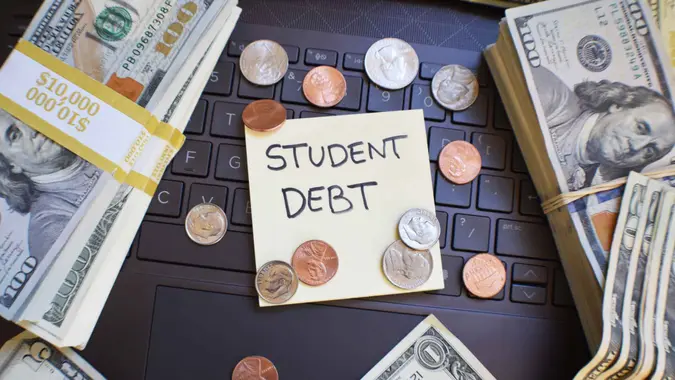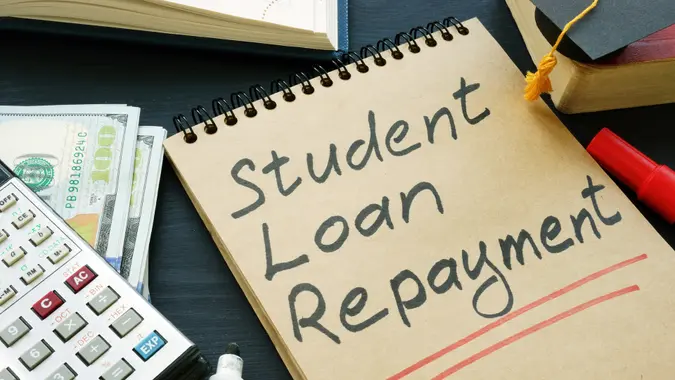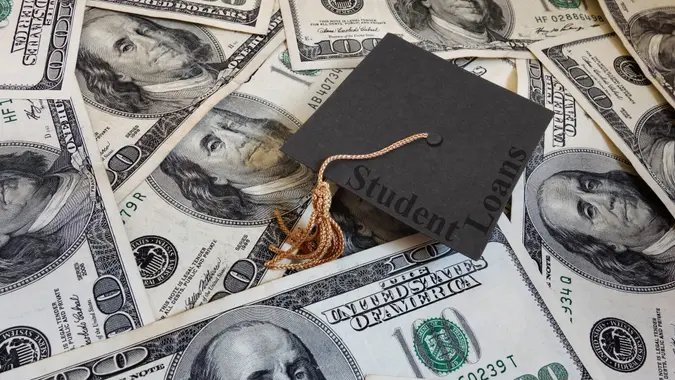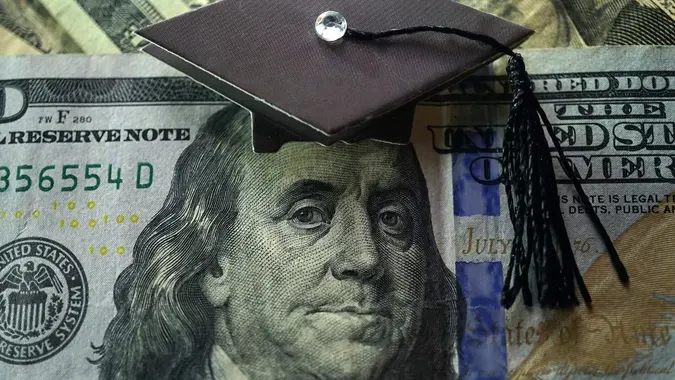6 Ways To Lower Your Student Loan Debt Interest Rate

Commitment to Our Readers
GOBankingRates' editorial team is committed to bringing you unbiased reviews and information. We use data-driven methodologies to evaluate financial products and services - our reviews and ratings are not influenced by advertisers. You can read more about our editorial guidelines and our products and services review methodology.

20 Years
Helping You Live Richer

Reviewed
by Experts

Trusted by
Millions of Readers
Getting out of student loan debt, especially when it comes to income-driven repayment plans, can be quite a burden. The Department of Education makes sure you have enough credits as an undergraduate student, but they don’t tend to look out for your credit score after you graduate.
Check Out: 3 Things You Must Do When Your Savings Reach $50,000
Trending Now: How Much Money Do Americans Have in Their Bank Accounts in 2025?
You’ll likely be earning the lowest pay of your career in your first job. For this reason alone, any way that you can reduce your monthly student loan payments will be a welcome relief.
While the federal government has offered some public service loan forgiveness for some students, there’s no guarantee that this policy will continue or that your specific loan will qualify. That’s why it’s a good idea to be proactive and do whatever you can to reduce your student loan debt interest rate. Here are six ways that can hopefully help lower your rates.
Check for Discounts
Most student loans offer some type of discount, so the loan interest might also have some negotiable wiggle room. Just like many auto or personal loans, for example, many student loans offer a 0.25% discount or more for setting up automatic payments.
Some banks may offer discounts for making a certain number of on-time payments, while others offer a discounted rate of 0.25% off your loan if you have an existing banking relationship. Any time you can shave a small percentage off of your loan interest you should do it. It will add up to big savings in the long run.
Negotiate
While you might not always succeed, it can pay to try to negotiate your rate with your lender. And in the financial world, you have more leverage if you’re falling behind on payments and struggling to pay.
Much like with credit card bills, you might also have more success negotiating if you find a lower rate at one of your lender’s competitors, offering the bank an opportunity to match it.
Refinance
Though it is dependent on your loan type, one of the best ways to get a lower rate on your federal student aid is to refinance it, just as you might with a traditional car loan or home mortgage. As lending is a competitive business, you may be able to shop around to snag an interest rate significantly lower than your current loan. This is particularly true in a falling-rate environment, which is likely to occur in 2025 as the Fed begins its planned series of rate cuts, outside of questionable student loan forgiveness programs.
To see how much you could save by refinancing, imagine you have a $25,000 student loan with a 10-year maturity and an 8% interest rate. If you could find a loan with a 6% rate, your payments would drop from $303.32 to $277.55. Even better, over the life of your loan, you’d save over $3,000 in interest.
Team Up With a Co-Signer With Better Credit
When it comes to loans, borrowers with better credit always get lower rates. If the interest rate on your student loan is high because you have bad credit, one way to get around this is to ask a willing co-signer with good credit to help you out.
For example, if you have a Parent Plus loan alternative, your co-signer will be fully responsible for making payments on the loan if you fail. This reduces the risk that the lender takes, resulting in a much lower interest rate on your loan.
Pick a Plan That Offers a Lower Rate
The federal government offers income-repayment plans that can help lower your payment in two ways. First, the plans automatically reduce your payment to between 10% and 20% of your discretionary income. If you aren’t earning that much, your payment might be lowered by a considerable amount.
Second, these plans extend the maturity date of your loan to 20 or 25 years, which can also lower your monthly payment. As an added kicker, whatever you haven’t been able to pay off by the loan’s maturity date will be forgiven.
Extend Your Loan’s Maturity Date
If you can either switch to a new loan or negotiate the terms of your current one, extending your maturity debt is a way to lower your payments. Note that an extended maturity date won’t necessarily lower your interest rate (unless you refinance), but it can reduce your monthly outflow.
Final Take To GO: Federal vs. Private Student Loans
Before you can start to lower your student loan interest rates, you need to understand the type of loan you took out. There are pros and cons to both federal and private student loans. However, it’s important to understand the differences, especially when it comes to loan rates and flexibility.
For example, federal student loan rates are generally lower than what you can get with a private student loan, and only federal student loans are eligible for forgiveness. However, not all borrowers can qualify for federal student loans. On the flipside, you’ll likely have a better chance to renegotiate your rate with a private student loan, as federal loan rates are set by Congress, not individual lenders.
John Csiszar contributed to the reporting for this article.
 Written by
Written by  Edited by
Edited by 
























